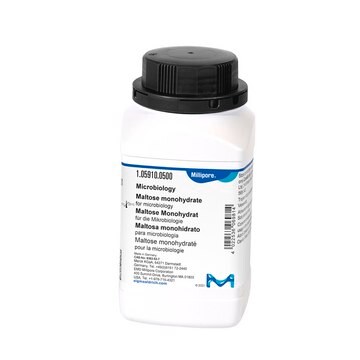M5895
D-(+)-Maltose monohydrate
≥98% (HPLC), BioReagent, suitable for cell culture, suitable for insect cell culture
Sinónimos:
4-O-α-D-Glucopyranosyl-D-glucose, Maltobiose
About This Item
Productos recomendados
origen biológico
potato
Nivel de calidad
Línea del producto
BioReagent
Análisis
≥98% (HPLC)
formulario
powder
actividad óptica
[α]20/D 128.0 to 132.0 °, c = 4% (w/v) in water + trace NH4OH
técnicas
cell culture | insect: suitable
cell culture | mammalian: suitable
impurezas
≤0.3% glucose
≤1.0% maltotriose
color
white
intervalo de pH útil
5.0-7 (25 °C, 180 g/L)
mp
102-103 °C
solubilidad
H2O: 50 mg/mL
aplicaciones
agriculture
temp. de almacenamiento
room temp
cadena SMILES
O.OC[C@@H](O)[C@@H](O[C@H]1O[C@H](CO)[C@@H](O)[C@H](O)[C@H]1O)[C@H](O)[C@@H](O)C=O
InChI
1S/C12H22O11.H2O/c13-1-4(16)7(18)11(5(17)2-14)23-12-10(21)9(20)8(19)6(3-15)22-12;/h1,4-12,14-21H,2-3H2;1H2/t4-,5+,6+,7+,8+,9-,10+,11+,12+;/m0./s1
Clave InChI
HBDJFVFTHLOSDW-DNDLZOGFSA-N
¿Está buscando productos similares? Visita Guía de comparación de productos
Descripción general
Aplicación
- Cell culture studies.
- Insect cell culture studies.
- To study the glass transition temperatures and phase relations for several saccharide-water systems.
- As medium supplement in the modified Luria-Bertani broth (LBM) medium for E. coli strains.
Otras notas
Código de clase de almacenamiento
13 - Non Combustible Solids
Clase de riesgo para el agua (WGK)
WGK 1
Equipo de protección personal
Eyeshields, Gloves, type N95 (US)
Certificados de análisis (COA)
Busque Certificados de análisis (COA) introduciendo el número de lote del producto. Los números de lote se encuentran en la etiqueta del producto después de las palabras «Lot» o «Batch»
¿Ya tiene este producto?
Encuentre la documentación para los productos que ha comprado recientemente en la Biblioteca de documentos.
Los clientes también vieron
Nuestro equipo de científicos tiene experiencia en todas las áreas de investigación: Ciencias de la vida, Ciencia de los materiales, Síntesis química, Cromatografía, Analítica y muchas otras.
Póngase en contacto con el Servicio técnico







